Laptop Mag Verdict
The Hippih hipKey pairs and alerts with ease, helping you keep closer tabs on your phone and your kids.
Pros
- +
Proximity alerts worked consistently
- +
Useful Motion mode
- +
Loud alerts
Cons
- -
Large dongle
- -
Cant't override phone's hardware mute
- -
iOS only
Why you can trust Laptop Mag
If you're constantly losing your phone or keys, or you want to keep better tabs on your kids, the hipKey by Hippah could help. The hipKey is a proximity and movement alarm that, when tethered via Bluetooth to an iOS device, supplies instant alerts if you've left something behind or a loved one has wandered off. Priced at $89.95, the hipKey is the most expensive of the proximity alerts we've tested, so read on to find out if this accessory does enough to justify the price tag.
Design
Click to EnlargeThe hipKey has a unique moon-shaped design, like a cookie with a small bite chomped off. In this concave space is the power button, action button and the speaker. The body of the device is a soft black plastic framed by an aluminum outer casing that gives the dongle style as well as strength.
The dongle measures 2 inches in diameter and is 0.5 inches thick, which is larger than both the Kensington Proximo Tag (1.5 inches in diameter and 0.25 inches thick). The Zomm Wireless Leash Plus measures 1.62 inches in diameter but is slightly thicker at 0.6 inches. The hipKey and the Wireless Leash both weigh the same, 0.8 ounces, and the Proximo was slightly less at 0.6 ounces.
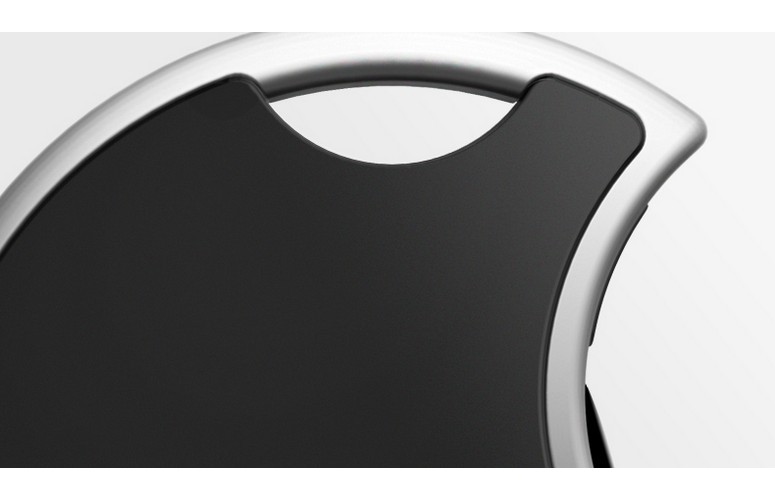
Click to EnlargeThe top of the device has a slot for a loop that can attach to a bag or key chain and the bottom of the device houses a microUSB charging port. The hipKey comes with a small elastic band, just like a hair-tie, for looping through the slot, which took away from the sleek style of the dongle. There's a small hipKey logo on both the front and back, right above the microUSB port.
Setup
The hipKey uses Bluetooth to connect to a supported smartphone, which is limited to the iPhone 5, 4S and 3rd generation and newer iPads. We paired the device by enabling Bluetooth on our iPhone 4S and opening the free hipKey app we downloaded from the App Store. We then held down the power key on the hipKey dongle until we heard a beep. Everything was paired and ready for use seconds later.
Features and Performance
There are three different modes for the hipKey proximity alert system: Alarm Mode, Child Mode and Motion Mode. The setup and management of each of these modes is accessed through the app, rather than on the device itself. Users select the mode by spinning the dial on the lower half of of the screen to set the desired functionality, and they can modify settings using the top half of the display.
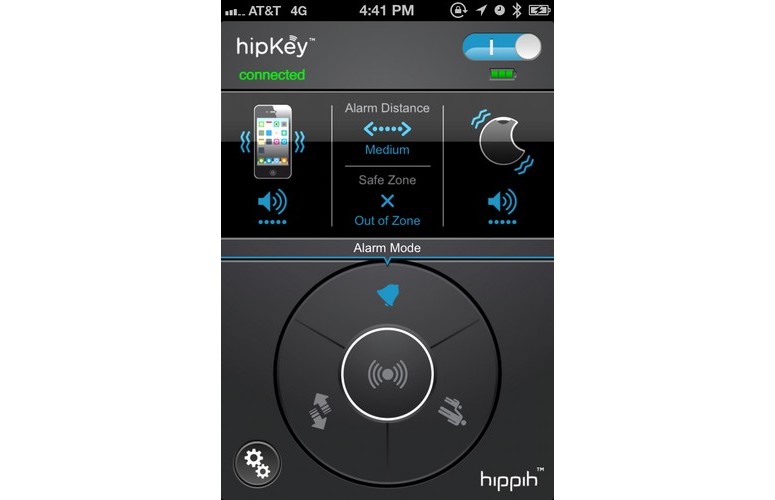
Click to EnlargeAlarm Mode is a proximity alarm that sends an alert to both the hipKey dongle and the paired phone when a certain distance is detected between the two devices. Users can choose from a short distance setting (6 - 16 feet), medium setting (50 - 65 feet) and a long setting (100 - 165 feet). In our testing, these distance triggers were fairly accurate. We could adjust the volume on both our phone and the dongle, which produced plenty of noise to be noticed.
Unfortunately, unlike the Kensington Proximo, the iPhone alert cannot override the system mute switch. We were able to override the system volume, changing this setting to max when out of range, but if our mute switch was active, our phone only vibrated. Additionally, there was no way to set a custom tone for either the phone or the hipKey's alerts.
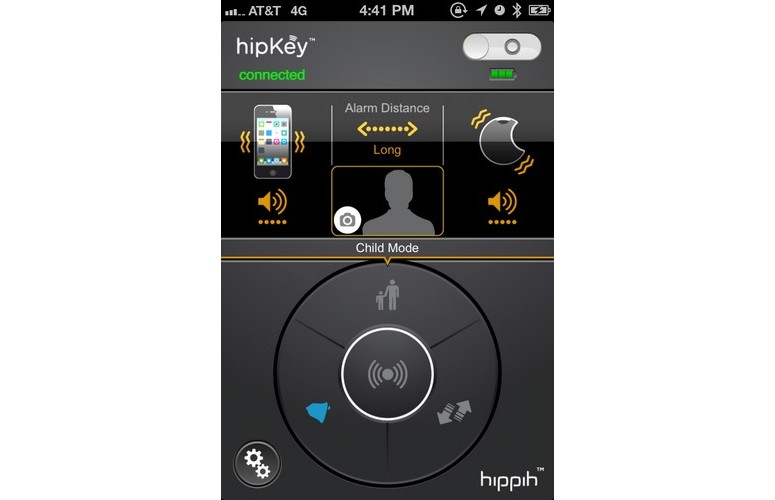
Click to EnlargeThe Safe Zone feature allowed us to designate certain areas where the proximity alert was disabled. We pinpointed our location on the map and could choose a safe radius between 80 meters to 400 feet. The first time we tried this feature, the GPS placed us on the other side of the globe, and the address search brought us to Brooklyn rather than Manhattan. We weren't able to fix this error without clicking and dragging the pin, but when we tried to add an entirely new location, the hipKey accurately pinpointed us immediately.
In Child Mode, parents can keep track of their kids by giving them the hipKey dongle. This works exactly the same as the Proximity mode, except users can add a picture of their kid to the app rather than setting a Safe Zone.
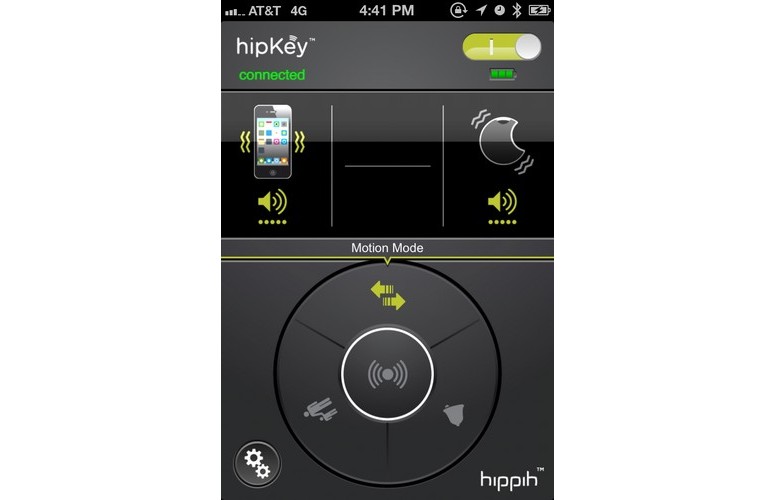
Click to EnlargeMotion Mode is a feature unique to the hipKey. When active, we received an alert on our phone any time the hipKey was moved. Unfortunately, there's no sensitivity setting, so even the slightest nudge will sound the alarm. But we could easily disable the alert from our phone, and the dongle went right on waiting for the next movement.
Also included, and always available, is the Find Me feature, which will set off an alert on the phone if activated from the dongle and vice versa. This feature worked fine in our testing, assuming the two devices were in Bluetooth range.
App Interface
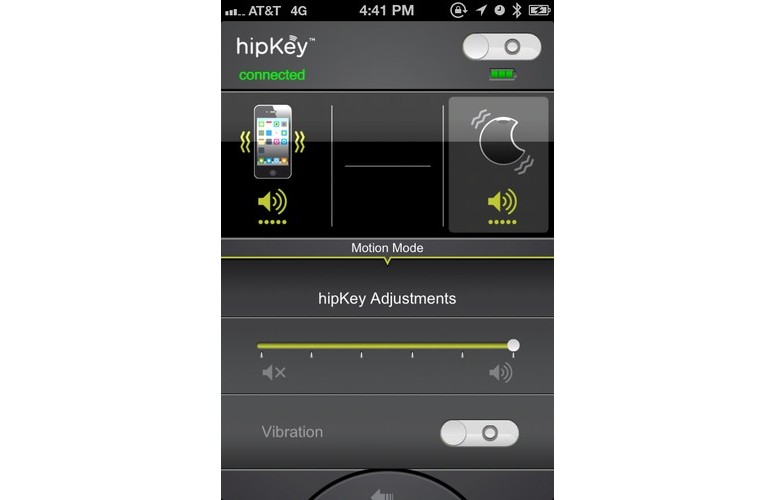
Click to EnlargeThe hipKey app has a very clean and modern interface. The top bar of the hipKey iPhone application shows whether your dongle is connected and the level of the battery and includes a toggle for enabling or disabling the current mode.
Right below this menu bar are the options for the current mode, which include the phone and dongle's alert settings, including volume level and vibration, as well as distance, zone and picture settings, as applicable.
At the bottom is a large dial for selecting between the three different modes. We wanted to be able to click on a certain mode and have the dial automatically turn to select it, but we instead needed to drag our finger until the appropriate mode was at the top of the dial.
In the middle of the dial is an alarm button, which sets off an immediate alert on the hipKey dongle, as long as the dongle is within Bluetooth range of the smartphone. There's a settings button in the bottom left corner, where Bluetooth and the LED light can be toggled on and off, the device can be unpaired, or users can quickly navigate to Hippih's website and support pages.
Only one mode can be activated at a time, so you'll have to choose either Motion, Action or Child rather than all of the above. While enabling Action and Child mode simultaneously would have been redundant, pairing Motion Mode with another might have been a nice feature.
Battery
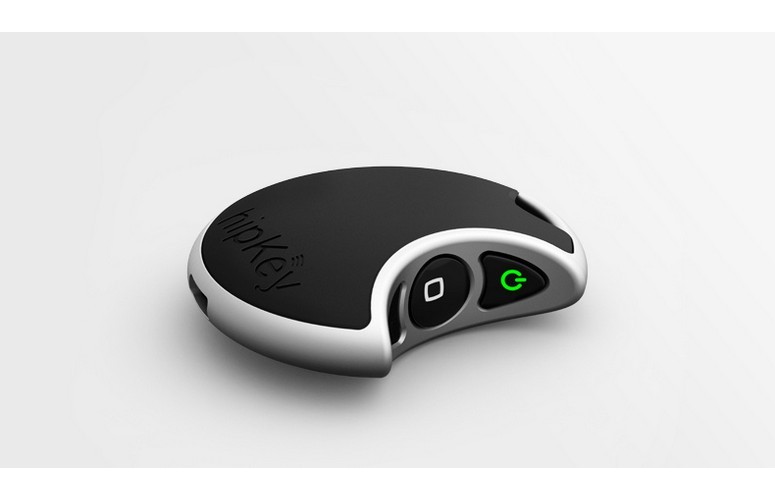
Click to EnlargeThe hipKey uses a rechargeable battery powered by a microUSB port. According to Hippih, the dongle can last from two to four weeks between charges, much longer than the two- to three-day life of the Zomm Wireless Leash Plus but not as long as the Kensington Proximo's six months of charge.
Battery life of the hipKey can be monitored through the iOS app, where the remaining power level is indicated by three power bars. We charged the device for four hours when we first received it, and the power level never dropped to two bars during our three days of testing.
Verdict
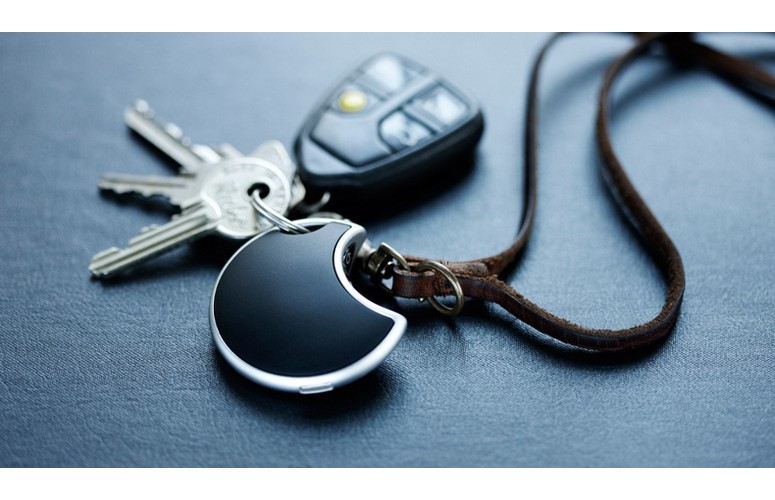
Click to EnlargeThe Hippih hipKey has all the features you would want from a proximity monitor and a little more. We appreciated the three separate modes, especially Motion mode, which is unique to the hipKey. However, at $89.95, the hipKey is more expensive than the Kensington Proximo, which costs $59.99 and comes with two dongles, making it the better buy. Overall, though, the hipKey is anything but square.
Hippih hipKey Proximity and Movement Alarm Specs
| Company Website | http://www.hippih.com |
